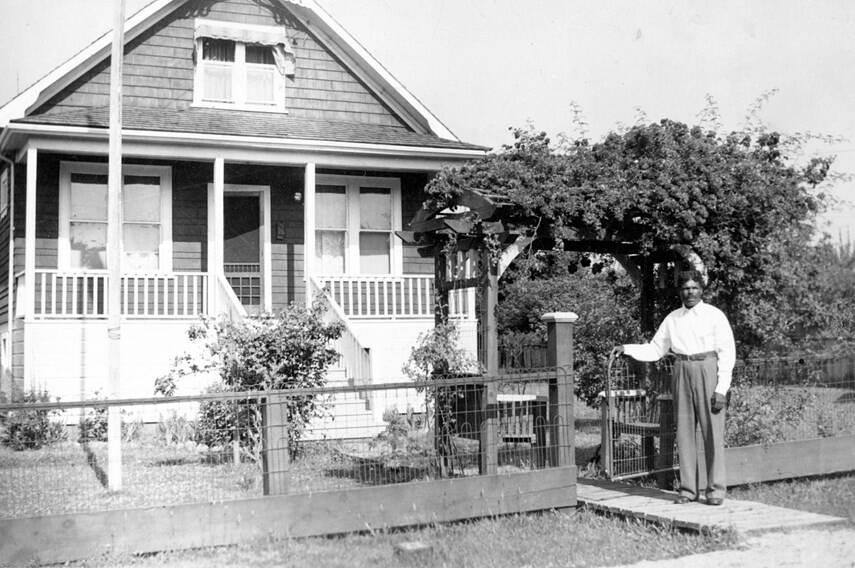The people keeping the North Shore’s busy shipping industry afloat weren’t always the united labour force we know today.
It took forward-looking attitudes of people like William Fitzclarence “Fitz” St. John and Fred Wilmot – both influential Black men who worked on the North Vancouver waterfont – to imagine and forge a better future for local workers.
At the turn of the 20th century, a large but intermittent workforce was needed to handle lumber from ships in Burrard Inlet. Concentrated in the Moodyville area, was an Indigenous contingent of longshoremen, who were known for their skill.
At the time, management stratified longshore workers along racial lines, explains Georgia Twiss, archives attendant at MONOVA: Museum of North Vancouver.
“That’s how the labour system tried to separate people from forming solidarity,” she said.
White workers were separated from the Indigenous longshoremen, who were grouped in with Chinese, Chilean and Hawaiian labourers. Among this segregated group was St. John, a charismatic Black immigrant who was known for being scholarly and a life-long union man.
Born in the mid-1870s to a wealthy family in British-ruled Barbados, the 1911 Canadian census lists his origins as Irish, which could mean that he descended from indentured plantation labourers. Alternatively, St. John may have been classified as Irish because the term was used as a catch-all for non-white British citizens at the time, Twiss said.
Seeking better compensation and more rights, the group of largely Indigenous longshoremen formed a union – one of the first in Vancouver’s shipping industry. When they joined the militant Industrial Workers of the World union, which prioritized class solidarity over racial divisions, St. John was secretary.
Known as the “Bows and Arrows,” the union met on the Sḵwx̱wú7mesh Úxwumixw (Squamish Nation) reserve in North Vancouver. While the group only lasted a year, it was highly influential in the formation of other unions later on, and in the political careers of those involved. Andy Paull, Joe Capilano (S7ápelek) and Dan George (Geswanouth Slahoot) were among the longshoremen, and would all play central roles in their respective Squamish and Tsleil-Waututh Nation governments.
“There’s an interesting thread that you can track about those people – those are really important figures, particularly in regards to the Indigenous community on the North Shore, being introduced to that kind of politics at that age and carrying it with them through the rest of their lives,” Twiss said.
St. John would continue his activism as well, participating in prominent dock workers confrontations in 1923 and 1935. In those years, much of unions’ progress was stifled by the use of scab labourers.
However, the Canadian government passed legislation during the Second World War that forced employers to negotiate with their workers. And in 1944, the Vancouver Waterfront Workers Association voted to join the International Longshore and Warehouse Union, which represents 7,200 members in B.C. today.
When St. John retired in 1953, after working as a longshoreman for 51 years, he was one of the first union members to be handed a pension cheque by a Vancouver shipping company.
Unions exploded post WWII, but not all were progressive
Fred Wilmot was described as a “practical campaigner” who advocated not only for the respect of a man’s work, regardless of colour, but also for women’s work as well.
As a shipbuilder and later a columnist, Wilmot would continue to spread his ideas, notably as part of his membership with the Boilermakers, a union known for its progressive and inclusive policies compared to other organizations. The Sheetmetal Workers Union, for example, accepted women members, but they weren’t allowed to vote, whereas all members were allowed to vote in the Boilermakers, regardless of race or gender, said Andrew Hildred, volunteer co-ordinator at MONOVA.
When Wilmot began working in the dockyards in 1944, he experienced racism almost immediately. After two days of training, Wilmot joined a rivet gang as a holder-on, where he would hold a rivet while a riveter used a rivet gun to drive them into place. He described working with an American worker, who immediately sabotaged Wilmot's work to make him look bad. But the American’s attempts failed, as his subterfuge was through and called out by the rest of the gang.
Later, Wilmot would go on to write a column in The Main Deck, a newspaper for the Boilermakers, called Loose Rivets, recalling the incident.
As his union gained traction, it became one of the largest in the industry, growing from around 200 to 13,000 members in its early years. They also sponsored musical and theatre productions and formed a labour arts guild.
“Through the Boilermakers Union, the Main Deck and the Shipyard Review, [Wilmot] was able to express the importance of unions and worker solidarity,” Hildred said.




